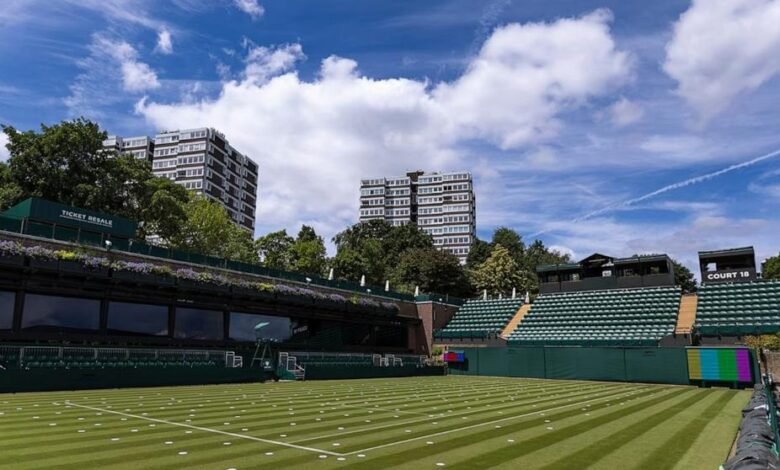The impressive science and art behind Wimbledon’s legendary grass courts

LONDON — Billie Jean King — tennis legend, pioneer and winner of 12 Grand Slams — once said that “tennis is the perfect combination of violent action taking place in an atmosphere of tranquility.”
If true, then Neil Stubley, head of courts and horticulture at Wimbledon, is responsible for the battlefield where some of the most epic matches in tennis history have been played.
From the longest tennis match in history between John Isner and Nicolas Mahut at the 2010 Wimbledon Championships, which lasted 11 hours and 5 minutes over three days, to Carlos Alcaraz’s electrifying victory over Novak Djokovic in 2023, Stubley oversees the meticulous process that ensures these courts meet the highest standards of playability and aesthetics, every 8mm blade of grass at a time.
“Next year’s championship starts the day after the last one ends,” Stubley told ABC News. “And that’s exactly what we do.”
As Chief Architect for Wimbledon’s Playing Surfaces, Stubley is responsible for the maintenance and management of the All England Club’s grass, acrylic and clay courts, as well as overseeing the club’s landscaping, ensuring that every blade of grass is in perfect condition for both the tournament and the club’s private members.
This involves an impressive amount of science, metrics and data — an art honed over generations at The All England Club — and for Stubley and his team, the learning, development and fine-tuning never stops.
“We’re going to be doing the number crunching not just throughout the year, but throughout the tournament,” Stubley said. “We’re going to be looking at how the baselines are wearing and how hard the courts have been, doing daily checks where each of our 38 courts will be measured 24 times a day, which means almost 20,000 readings throughout the tournament. This is all about science.”
The rigorous data collection may seem like a lot, but it allows Stubley and his 15 permanent staff members — who expand to a staff of 28 during the two-week tournament — to make the necessary adjustments to create optimal playing conditions, conditions that can affect match outcomes and tennis history.
“I would say getting the grass surfaces right at Wimbledon is like when a chef creates a new dish,” Stubley said. “You can have a dish that has the perfect ingredients, but if you don’t present it correctly, does it really matter? Or you can have ingredients that aren’t very good and you can present them well and make them look beautiful. What we try to do is marry the two. We use the best ingredients to produce the most beautiful aesthetic surface we can.”
The grass courts at Wimbledon have undergone significant changes over the years. Historically, the courts featured a mix of bentgrass and fescue grasses — which grew horizontally and vertically — creating a dense, fibrous surface that was often favored by serve-and-volley players due to its energy-absorbing characteristics.
However, by the late 1990s it became clear that these grasses were not hardy enough to withstand the two-week tournament and after extensive research and collaboration with turfgrass experts, Wimbledon transitioned to 100% perennial ryegrass.
This means that grass courts in 2024 will be more drought-tolerant, wear-resistant and vertically-grown, resulting in a thinner, more consistent playing surface, which Stubley says will improve the durability and performance of the courts and allow for more predictable ball bounce, which improves the overall quality of play.
“We’re always looking to improve that extra 1% every year,” Stubley told ABC News. “We always want to improve because the players are always improving. They’re getting stronger and faster. If you think about the players in Rod Laver’s era who were 5’5” and weighed 9 stone (126 pounds) compared to some of the players now who are 6’6” and 16 stone (224 pounds) of pure muscle who can run 20 meters in 2 to 3 seconds, there’s a lot more pressure on the playing surface and the need for the grass to survive that.”
In fact, for the six weeks leading up to the Championship, All England Club members will play on the courts to simulate tournament conditions, allowing Stubley and his team to make final adjustments based on real-world feedback and ensuring the courts are in tip-top condition when the world’s best players arrive.
While the main focus is performance for Stubley and his team, aesthetics also play a crucial role, with the lush, green appearance of the grass being an iconic feature of Wimbledon.
For Stubley, the goal is to strike the right balance between aesthetics and functionality, without having to compromise too much on either side and taking player safety into account.
“The baselines on a grass court deteriorate over the course of a tournament,” Stubley said. “You can’t have a tennis court at the end of Wimbledon looking the same as it did on the first day. That’s a pipe dream. Although we still try to achieve that when we’re looking at changing our grass cultivars, how much water to apply, the nutrition programs. In theory, it’s not possible, but it doesn’t stop you from wanting to.”
Stubley, who initially trained as a chef early in his career, transitioned into horticulture after realising his passions lay elsewhere, ironic considering he now considers himself a kind of chef and creator in many ways. But a fortuitous opportunity nearly 30 years ago gave him the chance to work as a summer intern at Wimbledon before deftly turning that into a permanent position, rising through the ranks to become head of the department and arguably one of the most experienced people in his field.
“One of the things I always tell people is that as long as we’ve done the best we can, as long as we haven’t cut corners and done our due diligence, if — for whatever reason — a player complains or something goes wrong, you can relax,” Stubley said. “It’s a rollercoaster once the tournament starts, and you’re just along for the ride no matter what. So whenever I wake up in the lead-up to Wimbledon and I can’t go back to sleep because I’m just thinking about what would happen if this or that happened, I’ll remind myself that as long as we do the best we can, that’s all that can be asked of us.”
Ultimately, it takes continuous innovation and meticulous attention to detail for Stubley and his team to preserve Wimbledon’s legacy as the pinnacle of grass-court tennis, a complex, year-round task that combines scientific rigor with horticultural expertise.
“I’m very fortunate to be in the position I’m in, and I’m very grateful for it,” Stubley said. “But I wouldn’t be here if it weren’t for all the hard work of the team that’s put into this.”




